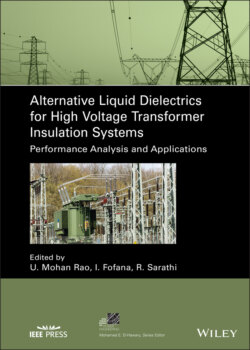Читать книгу Alternative Liquid Dielectrics for High Voltage Transformer Insulation Systems - Группа авторов - Страница 18
1.3 Insulation Aging Phenomena in Transformers
ОглавлениеThe service life of the oil‐filled apparatus is mainly attributable to the rate of degradation of the oil/paper insulation system. The preliminary causes for the degradation of the oil/paper insulation system are its decomposition aspects. The degradation process of the insulation system in oil‐filled apparatus is governed by the: (i) heat (dissipated through the core and winding assembly), (ii) moisture (ingressed from the air and liberated from cellulose), and (iii) oxygen (ingressed from air and liberated from oil/paper system). This operating heat will adversely affect the longevity and performance of the insulation system and the life of the apparatus if not dissipated properly in time [21]. As per IEC 60076‐2 standard (thermal layout), insulation paper will serve for up to 55 years and more, subject to the absence of dielectric defects in the insulation system. Albeit due care is taken by the manufacturers in designing, the generation of heat from coil–core assembly and subsequent degradation of the insulation system is unavoidable. The degradation of oil/paper insulation generates soluble and colloidal particles in the oil. This increases the oil viscosity, which hampers the flow rate in cooling tubes and affects the heat dissipation efficiency. This excess heat is responsible for the accumulation of hot spots within the transformer, which further intensifies the degradation mechanisms. The degradation mechanisms of an oil/paper insulation system include oxidation, hydrolysis, thermal stressing, and electrical stressing [22, 23]. These mechanisms introduce different by‐products that further act in degrading the oil/paper insulation system. The complete picture associated with the degradation process of oil/paper insulation has been illustrated in Figure 1.2.
Moisture and oxygen in the transformer may be ingressed from the external environment (for breathing transformers) or evolved from cellulose fibers of solid insulation. Moisture, oxygen, metals (components of the transformer), and heat (liberated from coil–core assembly) act as catalysts for deterioration of insulation systems and provide a scope for decomposing by‐products and acids. These catalysts and by‐products further expedite oxidation, hydrolysis, thermal, and electrical decomposition reactions with respect to operating times. All these degradation reactions are highly interrelated and the by‐products of one reaction act in catalyzing the other reactions. For analyzing the degradation perceptions of oil/paper insulation, these reactions may be approached thermally, electrically, chemically, and physically.
Thermally, oil gets oxidized and initiates sludging within the insulation oil while reducing the tensile strength of paper by paralyzing the cellulose fibers. Electrically, oil deteriorates and generates acids and free radicals with decomposition on a large surface of solid insulation. Chemically, the neutralization number of the oil gets adversely affected, and witnessing the evidence of furfural in oil. Physically, the osmotic behavior of moisture migrations through oil and paper with a change in temperature hampers the paper dryness and reduces the degree of polymerization of solid insulation by adding colloidal particles to oil [25, 26]. Ultimately, these degradation mechanisms are all about reducing the integral qualities of the insulation system with operating time. It is to be observed that, these aging mechanisms contribute to sludging, acidity, and decay contents, which reduce dielectric strength and increase the viscosity of the oil. These factors hamper the insulation properties and heat‐dissipating nature of oil, which are the primary objectives of the oil. It is to be understood that, these aging mechanisms contribute to the generation of furan contents, reduce the paper degree of polymerization and tensile strength, thus ruining the dielectric and mechanical integrity of solid insulation. Importantly, all the above‐discussed processes are also involved in the generation of several gasses that are dissolved in the insulation oil, which further ruins the physicochemical parameters of the insulation system.
Figure 1.2 Conceptual illustration of degradation in oil filled apparatus.
Source: Rao et al. [24] / with permission of IEEE.
Understanding the degradation process and its consequences that influence the performance and life of the oil‐filled apparatus indicates the importance of condition monitoring. The current state of knowledge on condition monitoring revealed that degradation/aging is associated with numerous parameters. Henceforth, monitoring and analyzing one single parameter will not reveal the exact situations prevailing with the insulation system. Proper condition monitoring analysis of oil/paper insulation with scheduled maintenance activities enables effective asset management and risk analysis. This also acts in transforming the conditioning monitoring aspects from detective‐corrective mode to strategic‐preventive mode. ASTM standard test methods are available for monitoring all the oil/paper insulation parameters to assess the quality of oil and the contemporary status of the oil‐filled apparatus. Hence, periodical assessment of insulation parameters will lead to early detection of the degradation perspectives of oil/paper insulation. The same analysis will be apparently useful in planning appropriate diagnostics and prognostics.
